“Global 3D Imaging Market to reach a market value of USD 117.9 Billion by 2030 growing at a CAGR of 19.2%”
The Global 3D Imaging Market size is expected to reach $117.9 billion by 2030, rising at a market growth of 19.2% CAGR during the forecast period.
Surgeons can use detailed 3D models of a patient's anatomy to plan procedures, enhancing precision and minimizing risks. Therefore, the healthcare & lifesciences segment captured $2,603.5 million revenue in the market in 2022. Its technologies are applied for surgical planning and navigation. 3D ultrasound imaging is employed in obstetrics for prenatal visualization of the fetus. It provides detailed three-dimensional views for improved prenatal care and patient communication. The technologies, such as functional MRI, contribute to neurology and brain imaging. It helps understand brain function, map neural pathways, and diagnose neurological disorders.
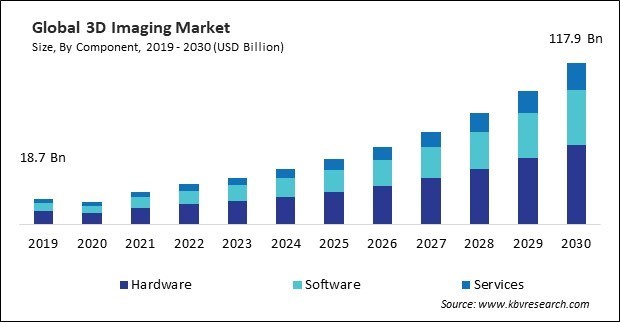
The major strategies followed by the market participants are Product Launches as the key developmental strategy to keep pace with the changing demands of end users. For instance, In May, 2023, Trimble, Inc. introduced the X9 3D laser scanning system. Built on proven laser scanning technologies, it featured innovations like Trimble X-Drive for automatic calibration and survey-grade self-leveling. Additionally, In September, 2022, Autodesk, Inc. launched Maya Creative. It featured powerful 3D tools for modeling, animation, and rendering in film, TV, and game development, including the industry-standard creative toolset and the Arnold renderer for complex VFX and animation workflows.
Based on the Analysis presented in the KBV Cardinal matrix; Google LLC is the forerunner in the market. Companies such as Adobe, Inc., GE HealthCare Technologies, Inc., Trimble, Inc. are some of the key innovators in Market. In June, 2022, Adobe, Inc. expanded its Adobe Substance 3D with enhanced extensibility and performance. Updates included a 3D Materials SDK, powerful plugins, and native support for Apple M-series chips in Painter, Designer, and Sampler. Adobe also previewed innovations from Adobe Research, highlighting new ways to create immersive experiences, and showcased how leading brands used Substance 3D tools for unique customer experiences.
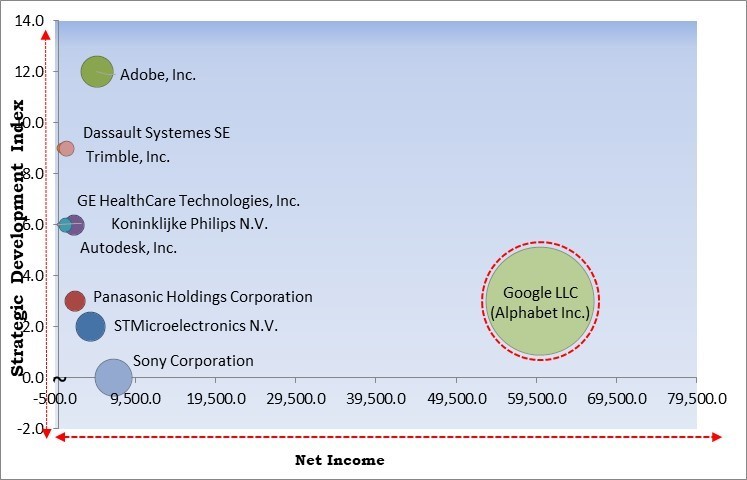
It enables robots to recognize and locate objects in a three-dimensional space accurately. This is crucial for tasks such as pick-and-place operations in manufacturing and logistics. It is used for quality inspection in manufacturing processes. Robots equipped with 3D vision can identify defects, measure dimensions, and ensure the overall quality of products. It enables robots to pick and sort bins in warehouses and manufacturing facilities. The technology helps robots identify and grasp items from bins with varying shapes and sizes. Autonomous vehicles equipped with its systems can navigate and extract resources efficiently in mining operations. The technology aids in mapping underground environments and avoiding obstacles. In the food industry, robots with its capabilities are used for sorting, quality inspection, and packaging, ensuring efficiency and hygiene. Thus, the market is expanding significantly due to the wide range of applications in robotics and automation.
Moreover, in the retail sector, it facilitates virtual try-ons, allowing customers to visualize and try products virtually before making a purchase decision. E-commerce platforms utilize this for interactive product visualizations, enhancing the online shopping experience. In retailing electronics, such as smartphones and laptops, it allows for interactive visualizations. Customers can rotate, zoom, and explore products in detail, improving their understanding of features and design. This lessens the possibility of returns because of sizing problems. In the beauty sector, It offers virtual makeup trials. Customers can observe the appearance of various makeup products on their look before committing to cosmetic purchases. Hence, because of the expanding e-commerce and retail applications, the market is anticipated to increase significantly.
The high initial investment required for implementing these solutions may extend businesses' time to realize a positive return on their investment. This prolonged ROI period can be a deterrent for organizations considering the adoption of these technologies. Industries that allocate a significant portion of their budget to implementing these systems may face constraints in allocating funds for other critical areas, such as research and development (R&D). The high cost of implementation may divert financial resources away from investment in research and development. This can result in slowed innovation, limiting the introduction of new features, functionalities, and advancements in these technologies. Large enterprises with greater financial resources may be more capable of absorbing the high costs associated with the implementation. This can lead to an adoption bias favoring larger organizations, potentially leaving smaller businesses and industries underserved. Hence, high cost of implementation in 3D imaging are a significant challenge that hampers the growth of market.
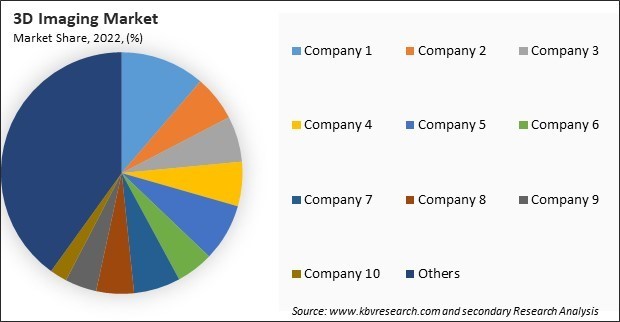
The leading players in the market are competing with diverse innovative offerings to remain competitive in the market. The above illustration shows the percentage of revenue shared by some of the leading companies in the market. The leading players of the market are adopting various strategies in order to cater demand coming from the different industries. The key developmental strategies in the market are Product Launches and Product Expansions.
Under hardware component, the market is segmented into 3D camera, 3D scanner, 3D display, and others. In 2022, the 3D display segment witnessed the largest revenue share in the market. The demand for 3D displays is increasing in VR and AR applications, where realistic and immersive experiences are crucial. This includes gaming, simulation, training, and design visualization. 3D displays are used in cinemas, gaming, and home entertainment systems. The demand for 3D content and displays in these sectors may drive market segment growth. 3D displays are valuable in educational settings for interactive learning experiences. Virtual simulations and training programs benefit from realistic 3D visuals.
Based on software type, the market is fragmented into 3D modeling software, 3D scanning software, 3D layout & animation software, 3D visualization & rendering software, image reconstruction software, and others. In 2022, the 3D modeling software segment dominated the market with maximum revenue share. 3D modeling software is extensively used to create animated films, video games, and visual effects. 3D modelling is integral to product design, enabling designers to create detailed digital prototypes. This supports the iterative design process, accelerates product development, and facilitates communication between design teams and manufacturers.
By technology, the market is classified into stereoscopic imaging, structured light imaging, laser-based imaging, holographic imaging, and time-of-flight imaging. The stereoscopic imaging segment covered a considerable revenue share in the market in 2022. Stereoscopic imaging has been widely adopted in the entertainment industry, especially in cinemas. The production of 3D movies and the availability of stereoscopic content contribute to enhanced viewer experiences, attracting audiences seeking immersive visual entertainment. Stereoscopic imaging is employed in educational simulations and training programs. Stereoscopic imaging enhances architectural visualization by providing a more realistic representation of buildings and spaces. Architects and designers use this technology to create immersive presentations for clients and stakeholders.
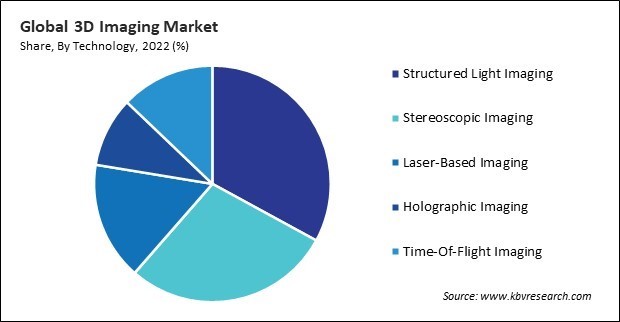
By component, the market is categorized into hardware, software, and services. In 2022, the hardware segment held the highest revenue share in the market. Advanced computing hardware, including Graphics processing units (GPUs) and specialized AI chips, supports the implementation of artificial intelligence algorithms in 3D imaging for tasks such as object recognition and reconstruction. The hardware in mobile devices, including cameras and sensors, facilitates AR applications that overlay 3D content onto the real-world environment. Embedded systems in portable devices contribute to the development of handheld 3D scanners, enabling users to capture 3D data on the go.
On the basis of vertical, the market is divided into aerospace & defense, automotive, manufacturing, healthcare & lifesciences, architecture & construction, media & entertainment, retail & ecommerce, government & defense, and others. In 2022, the automotive segment held the highest revenue share in the market. The technologies are applied for quality control and inspection of automotive components during manufacturing. It supports the aftermarket industry by providing accurate digital models of vehicles and components. This aids in the design and production of aftermarket parts and accessories. Automotive manufacturers use it to create virtual reality showrooms. This allows customers to experience vehicles virtually, providing an immersive and interactive shopping experience.
Free Valuable Insights: Global 3D Imaging Market size to reach USD 117.9 Billion by 2030
Region-wise, the market is analysed across North America, Europe, Asia Pacific, and LAMEA. In 2022, the North America region led the market by generating the highest revenue share. North America has been at the forefront of adopting these technologies in healthcare. Dental clinics in North America often integrate 3D imaging for improved patient care. Industries in North America, including aerospace, automotive, and electronics, leverage these imaging for product design, prototyping, and quality control. Hollywood and the broader entertainment industry in North America extensively use it for creating realistic visual effects, animation, and immersive experiences in films.
| Report Attribute | Details |
|---|---|
| Market size value in 2022 | USD 29.4 Billion |
| Market size forecast in 2030 | USD 117.9 Billion |
| Base Year | 2022 |
| Historical Period | 2019 to 2021 |
| Forecast Period | 2023 to 2030 |
| Revenue Growth Rate | CAGR of 19.2% from 2023 to 2030 |
| Number of Pages | 446 |
| Number of Tables | 733 |
| Report coverage | Market Trends, Revenue Estimation and Forecast, Segmentation Analysis, Regional and Country Breakdown, Competitive Landscape, Market Share Analysis, Porter’s 5 Forces Analysis, Company Profiling, Companies Strategic Developments, SWOT Analysis, Winning Imperatives |
| Segments covered | Component, Technology, Vertical, Region |
| Country scope |
|
| Companies Included | GE HealthCare Technologies, Inc., Autodesk, Inc., STMicroelectronics N.V., Panasonic Holdings Corporation, Sony Corporation, Trimble, Inc., Koninklijke Philips N.V., Dassault Systemes SE, Adobe, Inc. and Google LLC (Alphabet Inc.) |
By Component
By Technology
By Vertical
By Geography
This Market size is expected to reach $117.9 billion by 2030.
Wide range of applications in robotics and automation are driving the Market in coming years, however, High cost of implementation in 3D imaging restraints the growth of the Market.
GE HealthCare Technologies, Inc., Autodesk, Inc., STMicroelectronics N.V., Panasonic Holdings Corporation, Sony Corporation, Trimble, Inc., Koninklijke Philips N.V., Dassault Systemes SE, Adobe, Inc. and Google LLC (Alphabet Inc.)
The expected CAGR of this Market is 19.2% from 2023 to 2030.
The Structured Light Imaging segment is leading the Market by Technology in 2022; there by, achieving a market value of $34.8 billion by 2030.
The North America region dominated the Market by Region in 2022, and would continue to be a dominant market till 2030; there by, achieving a market value of $41.7 billion by 2030.
Our team of dedicated experts can provide you with attractive expansion opportunities for your business.
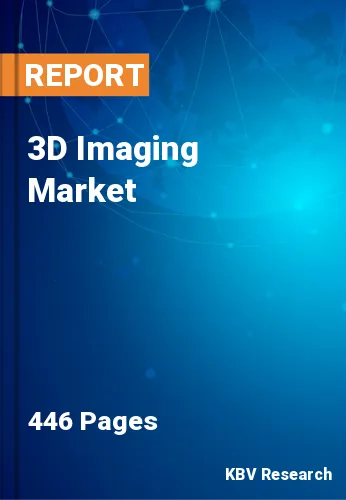
 Drivers
Drivers
 Restraints
Restraints
 Opportunities
Opportunities
 Challenges
Challenges
